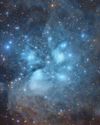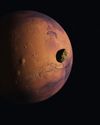
One of the greatest mysteries that astronomers hope to one day solve is how our Solar System formed. It’s long been known that star systems are shaped by collisions and other disruptive events, so whenever scientists are lucky enough to directly observe such an occurrence, it takes researchers one step closer to the answer.
In 2021, scientists made a breakthrough. They used the Atacama Large Millimeter/ submillimeter Array (ALMA), along with the Karl G. Jansky Very Large Array (VLA), to peer at the Z Canis Majoris (Z CMa) star system. They wanted to study a stream of dust and gas that was stretching far into the darkness of space. In doing so they happened to capture an object which they could see had smashed into the protoplanetary disc of leftover material surrounding the protostar pair, and it got them very excited indeed.
Although astronomers had previously observed the effects of the collision – the streamer, as it’s referred to – this time researchers found something else. “We detected it almost purely by chance,” says Ruobing Dong, an astronomer at the University of Victoria in Canada and principal investigator of the study. “It was like going on a hiking trip, finding a beautiful leaf on a tree and taking a photo of it, only to examine the photo afterwards and find lightning in the background sky.”
Esta historia es de la edición Issue 127 de All About Space.
Comience su prueba gratuita de Magzter GOLD de 7 días para acceder a miles de historias premium seleccionadas y a más de 9,000 revistas y periódicos.
Ya eres suscriptor ? Conectar
Esta historia es de la edición Issue 127 de All About Space.
Comience su prueba gratuita de Magzter GOLD de 7 días para acceder a miles de historias premium seleccionadas y a más de 9,000 revistas y periódicos.
Ya eres suscriptor? Conectar

MYSTERIES OF THE UNI WHERE ARE ALL THE SPIRAL GALAXIES?
There are far fewer spiral galaxies than elliptical ones in the Supergalactic Plane, and scientists are keen to discover why

ZOMBIE STARS
+10 OTHER TERRIFYING SPACE OBJECTS

HOW TO BEAT LIGHT POLLUTION
Thought it was impossible to observe the wonders of the night sky from towns and cities? Think again. Follow our tips and tricks on successfully observing through sky glow

15 STUNNING STAR CLUSTERS
These beautiful stellar groupings are spattered across the cosmos

Eileen Collins "It was a difficult mission...we were the first to see Mir"
Having served as both the first female pilot and first female commander of NASA's Space Shuttle, Collins boosted the involvement of women in space exploration to a whole new level

MARS LEAKS FASTER WHEN IT'S CLOSER TO THE SUN
The Red Planet has lost enough water to space to form a global ocean hundreds of kilometres deep

FUTURE TECH KANKOH-MARU
This ambitious reusable spacecraft will be capable of taking 50 people to and from orbit

THE FINAL FRONTIER
Beyond the reach of the Sun is a fascinating region of the cosmos that were only just beginning to explore

A long-lost moon could explain Mars' weird shape and extreme terrain
A long-lost moon could explain why Mars is so different from the other rocky planets in the Solar System. Today Mars has two tiny moons.

A sprinkling of cosmic dust may have helped kick-start life on Earth
Cosmic dust may have helped kick-start life on Earth. New findings challenge a widely held assumption that this wasn't a plausible explanation.